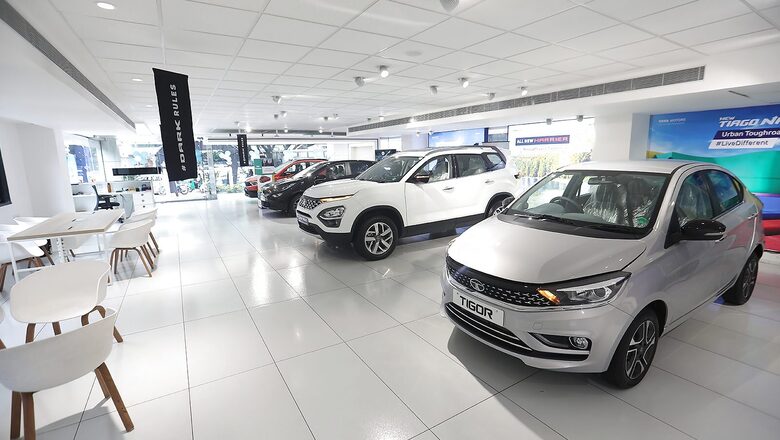
views
It’s been over six months since Guenter Karl Butschek stepped down as chief executive officer and managing director of Tata Motors. Butschek, who cited personal reasons for his decision to relocate to Germany, continues to be associated with the company as a consultant until March.
However, Tata Motors still hasn’t found a replacement for Butschek who is credited with helping the company’s struggling passenger car business turn a difficult corner during his five-year tenure.
When Butschek resigned at the end of June, Tata Motors appointed Girish Wagh as executive director on the company board from July 1, 2021, and to head the commercial vehicles division. Wagh, along with Shailesh Chandra as president of passenger vehicles and Thierry Bollore as CEO of Jaguar Land Rover, would work closely with Chairman N Chandrasekaran.
Butschek’s departure was another disruptive point in the somewhat chequered path that the company has taken in terms of its leadership. Tata Motors had appointed Daimler executive Marc Llistosella to take over from Butschek. However, it was widely reported that Llistosella changed his mind.
Tata Motors did not respond to queries on whether it would appoint a CEO to fill the vacancy any time soon. The $35 billion automobile manufacturer has a portfolio that includes a range of cars, utility vehicles, trucks, buses and defence vehicles.
There had been speculation over the possible candidature of veteran auto CEO Gurpratap Boparai, who recently departed from Skoda Volkswagen Group, but he emphatically denied that.
“I won’t be joining Tata Motors," Boparai said when asked about the possible move.
CEO churn
Leadership turnover isn’t new at Tata Motors. In 2011, group CEO Carl-Peter Forster quit for personal reasons after 18 months on the job. Karl Slym, who joined in 2012, died in a tragic accident in a Bangkok hotel in 2014.
After Butschek joined in 2016, Tata Motors generated stronger sales and introduced the kind of vehicles that the market seems to want, although the company still needs to accelerate on a number of different products.
In the past three years, the Tata Motors stock price has risen almost three-fold and things seem on track with the attention and sales that its electric car Nexon has received.
“When Butschek took over, the vision was to expand the product portfolio and be present in the growing segments along with a renewed focus on quality, safety and technology. All that is now showing tangible outcomes in terms of great sales figures over the last several months and intangible benefits like improved perception about Tata cars and the overall brand value," said Suraj Ghosh, associate director at IHS Markit. “New brand messaging and a good value-for-money proposition are convincing enough for new car buyers to get attracted to it. Additionally, the early and aggressive entry into the electric vehicle space has also raised its game higher compared to peers."
Tata Motors can’t afford to slow down at this stage, he said, emphasising the need for a CEO with a strategic vision for the company.
“Tata has to maintain its edge on new product development and be committed to safe and high-quality products with great value for money. As the market is becoming increasingly complex and dynamic in terms of policies, regulations, customer evolution, and competition, having a robust and visionary strategy will be key as well," Ghosh said.
Back in 2007, Tata Motors had a market share of a healthy 17 percent, after which it started losing traction – mostly due to the lack of vibrant new models, apart from factors such as the economy and increased competition. Market share shrank to about 5 percent in 2019 before coming back up.
Challenges ahead
At present, Tata Motors has a market share of about 12 percent, according to Hong Kong-based brokerage and investment group CLSA. It was the third-largest auto company in India with 332,000 units shipped in 2021 compared with second-placed Hyundai Motor, which sold 500,000 passenger cars.
However, there could be clouds gathering on the horizon for Tata Motors. Early in January, CLSA cut its rating on the company and lowered the target price, saying its domestic business is overvalued.
Tata Motor shares rose 3 percent to Rs 525 at the close on the BSE on January 17. The stock has doubled over the past year.
One challenge at hand for Tata Motors is that product development takes inordinately longer than in other companies, experts said. Kia launched market-leading SUVs such as the Seltos and Sonet in just three years.
According to Gautam Sen, automotive author, Tata Motors could have redone many JLR-styled cars and successfully badged them under Tata and sold them in India.
“The auto company INEOS capitalised on the missed opportunity and developed the Grenadier. Tata Motors should have developed a body-on-frame Defender for the 21st century instead," said Sen.
The Grenadier from INEOS Automotive is essentially a remake of the Land Rover and while the British media lambasted it initially, they later acknowledged it was a decent product.
The other factor is electric vehicles. While Tata Motors is betting big on its EV game and company officials say they have a three-platform strategy to make it happen, the company doesn’t yet have a full-scale electric vehicle platform to make EVs.
In essence, internal combustion engine cars such as the Nexon and Tiago are being “garage-jobbed" and electrified, which is suitable for the present size of the market but may not suffice when volumes pick up and competition takes off, analysts said.
At such a stage, the question that remains is why Tata Motors doesn’t have a CEO. Is it because of a talent crunch or is the company happy with the present arrangement of having an executive committee to run the business?
Tata Motors declined to comment on the specifics around that call.
According to one auto industry official, there’s a sense that the Tatas are happy with the current arrangement, which allows them to operate in a nimble fashion.
Also Watch:
Vision, accountability
Experts, though, see the absence of a CEO/MD as a potential hurdle.
“Of course, it does need a CEO, and not for short-term gains but with long-term vision as well," said Sen. “The sector is going to change rapidly and to be able to not miss the boat it needs a strong decisive CEO."
“In any organisation, ultimately it is one person who needs to be accountable from the operational team to its stakeholders and shareholders in general and that goes for any company, regardless of size," said a management consultant who declined to be identified. “It is unusual to see models of leadership with three or four senior people reporting to a board."
Other auto companies have shown that it’s important for a stable CEO to helm the company to ensure continuity of strategy and that targets are met. Maruti Suzuki, the market leader in India, appointed Kenuchi Ayukawa as CEO and MD in 2013 and he continues to run the company. Prior to him, Shinzo Nakanishi was at the helm of Maruti from 2007 to 2013.
An analyst who declined to be identified said that while a leadership structure can be used to run a company, it could become a challenge in the long term when competition ramps up and factors such as duty structures and emission laws change and a CEO is needed to make calls in real time.
The other factor is whether companies are obsessed with the idea of recruiting offshore talent in order to be seen as a global car company.
Kaushik Madhavan, an auto analyst and former VP with Frost & Sullivan, said that “the ecosystem of international talent for auto majors is very expensive and takes time to rope in. One mustn’t ignore the limited but present and very competent pool of talent in India’s own backyard who are now running large supplier brands and companies and more than ready to lead Indian companies."
Read all the Latest Auto News here




















Comments
0 comment